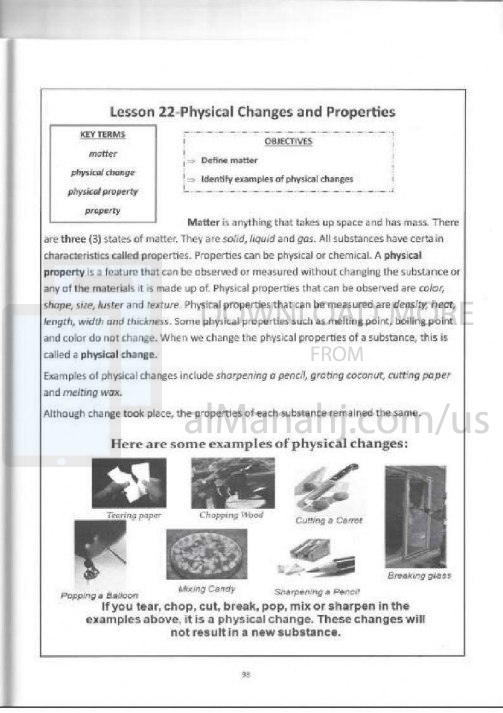| You are here: Almanahj Website ⇒ American curriculum ⇒ 5th Grade ⇒ Physics ⇒ Term 1 | ||
|---|---|---|
Worksheet about Physical and Chemical Changes | ||
|---|---|---|
| Subject: Physics | ||
| 5th Grade | ||
| Term 1 | ||
| Year: 2023/2024 | ||
| Size: 699KB | ||
| Number of clicks: 132 | ||
| Publish date:November 07, 2023 | ||
| Added by: Eman | ||
| Last download date: 2024-08-23 20:32:05 | ||
| Updated by: Eman9966 on 2023-11-07 13:12:27 | By: theodor dean19862 | |
| File info: Physical and chemical changes are two types of transformations that can occur in matter. Here's a description of each: 1. Physical Changes: Physical changes refer to alterations in the physical properties of a substance without any change in its chemical composition. In other words, the substance remains the same at the molecular level. Some characteristics of physical changes include: - Change in state: Physical changes can involve a change in the state of matter, such as when ice melts to form water or water vaporizes to form steam. - Change in shape or size: Physical changes can also involve changes in the shape or size of a substance without altering its chemical composition. For example, when a piece of paper is torn into smaller pieces or when a clay sculpture is molded into a different shape. - Reversible: Most physical changes are reversible, meaning the substance can be changed back to its original state without any chemical reactions occurring. Overall, physical changes involve alterations in the physical properties of a substance, but the fundamental composition of the substance remains the same. 2. Chemical Changes: Chemical changes, on the other hand, involve the formation of new substances with different chemical compositions through chemical reactions. During a chemical change, the bonds between atoms are broken and new bonds are formed, resulting in a transformation at the molecular level. Some characteristics of chemical changes include: - Formation of new substances: Chemical changes result in the creation of new substances with different properties from the original substances. For example, when iron rusts, it undergoes a chemical change, forming iron oxide. - Energy changes: Chemical changes often involve energy changes, such as the release or absorption of heat, light, or sound. These energy changes are indicative of the breaking and forming of chemical bonds. - Irreversible: Unlike physical changes, most chemical changes are irreversible. Once a chemical reaction occurs, it is difficult or impossible to reverse the process and return to the original substances. Chemical changes involve the rearrangement of atoms and the formation of new substances with different chemical properties. It's important to note that distinguishing between physical and chemical changes can sometimes be challenging, as some transformations may exhibit characteristics of both. However, understanding these concepts can help in identifying and categorizing different types of changes that occur in matter. | ||
| Downloading link Worksheet about Physical and Chemical Changes |
|---|
|
1699358810.pdf
The file is being prepared for download
|
| File images |
|---|
 |